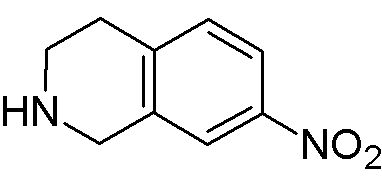7-Nitro-1,2,3,4-tetrahydroisoquinoline is widely utilized in research focused on:
- Pharmaceutical Development: This compound serves as a valuable intermediate in the synthesis of various pharmaceuticals, particularly those targeting neurological disorders.
- Neurotransmitter Research: It plays a role in studying neurotransmitter systems, aiding researchers in understanding brain functions and developing treatments for mental health conditions.
- Analytical Chemistry: Used as a reference standard in analytical methods, it helps ensure the accuracy and reliability of chemical analyses in laboratories.
- Organic Synthesis: The compound is a key building block in organic synthesis, allowing chemists to create complex molecules with specific properties for various applications.
- Material Science: Its unique properties make it useful in developing new materials, particularly in the field of polymers and coatings that require specific chemical characteristics.
General Information
Properties
Safety and Regulations
Applications
7-Nitro-1,2,3,4-tetrahydroisoquinoline is widely utilized in research focused on:
- Pharmaceutical Development: This compound serves as a valuable intermediate in the synthesis of various pharmaceuticals, particularly those targeting neurological disorders.
- Neurotransmitter Research: It plays a role in studying neurotransmitter systems, aiding researchers in understanding brain functions and developing treatments for mental health conditions.
- Analytical Chemistry: Used as a reference standard in analytical methods, it helps ensure the accuracy and reliability of chemical analyses in laboratories.
- Organic Synthesis: The compound is a key building block in organic synthesis, allowing chemists to create complex molecules with specific properties for various applications.
- Material Science: Its unique properties make it useful in developing new materials, particularly in the field of polymers and coatings that require specific chemical characteristics.
Documents
Safety Data Sheets (SDS)
The SDS provides comprehensive safety information on handling, storage, and disposal of the product.
Product Specification (PS)
The PS provides a comprehensive breakdown of the product’s properties, including chemical composition, physical state, purity, and storage requirements. It also details acceptable quality ranges and the product's intended applications.
Certificates of Analysis (COA)
Search for Certificates of Analysis (COA) by entering the products Lot Number. Lot and Batch Numbers can be found on a product’s label following the words ‘Lot’ or ‘Batch’.
*Catalog Number
*Lot Number
Certificates Of Origin (COO)
This COO confirms the country where the product was manufactured, and also details the materials and components used in it and whether it is derived from natural, synthetic, or other specific sources. This certificate may be required for customs, trade, and regulatory compliance.
*Catalog Number
*Lot Number
Safety Data Sheets (SDS)
The SDS provides comprehensive safety information on handling, storage, and disposal of the product.
DownloadProduct Specification (PS)
The PS provides a comprehensive breakdown of the product’s properties, including chemical composition, physical state, purity, and storage requirements. It also details acceptable quality ranges and the product's intended applications.
DownloadCertificates of Analysis (COA)
Search for Certificates of Analysis (COA) by entering the products Lot Number. Lot and Batch Numbers can be found on a product’s label following the words ‘Lot’ or ‘Batch’.
*Catalog Number
*Lot Number
Certificates Of Origin (COO)
This COO confirms the country where the product was manufactured, and also details the materials and components used in it and whether it is derived from natural, synthetic, or other specific sources. This certificate may be required for customs, trade, and regulatory compliance.


